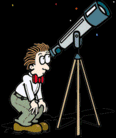As the summer nights in the northern hemisphere grow short, Saturn fades quickly to the west and with it takes our great views of the solar system’s most serene and restful planet. If you were to walk out tonight and point a small telescope Saturn’s way, what would you see? Step right up the the StarGazer’s Telescope and let’s look…
Saturn, the sixth planet from the Sun, has the most spectacular set of rings in the solar system – ones which are easily seen in even the smallest of telescopes. Even at roughly 793 million miles away, we can still see this thin band of icy particles and rubble circling the magnificent planet. Maybe it was a comet that ventured too close… Perhaps Saturn’s moons collided… But no matter what the explanation is, the gentle yellow serenity of Saturn is something to behold.
Can you see Saturn’s gentle, yellow color? Much of the atmosphere of Saturn is made of hydrogen and helium, but there is also water vapor, methane, ammonia, and nitrogen. While it looks warm by nature, these cloudtops are quite cold, about –220° Fahrenheit. Winds in the upper atmosphere reach 500 meters (1,600 feet) per second in the equatorial region which is about five times faster than any hurricane force wind ever encountered here on Earth. These super-fast winds, combined with heat rising from within the planet’s interior, cause the yellow and gold bands visible in the atmosphere.
Did you know Saturn was the most distant of the five planets known to the ancients? In 1610, Galileo Galilei was the first to gaze at Saturn through a telescope and his view wasn’t even as close to as good as what we see here. In 1659, Christiaan Huygens, used a far more powerful telescope and announced that Saturn was surrounded by a thin, flat ring. A few years later in 1675, Jean-Dominique Cassini discovered a ‘division’ between what are now called the A and B rings. Thanks to modern science, we now know the gravitational influence of Saturn’s moon Mimas is what’s responsible for the black band known as Cassini Division. Can you see it peeking in and out when the atmosphere gets steady? Even from all these millions of miles away, we’re still able to resolve a feature which is 4,800 kilometers (3,000 miles) wide.
Do you want a real rush? While you’re looking at Saturn, click here. This is an audio file of radio emissions from Saturn. The Cassini spacecraft began detecting these radio emissions in April 2002, when Cassini was 374 million kilometers (234 million miles) from the planet, using the Cassini radio and plasma wave science instrument. Isn’t it creepy? It’s also kind of beautiful too… Like listening to whale songs.
Now move over… It’s my turn at the eyepiece.


that is simply amazing. Awesome article, thank you!
Now where could I go about getting such a telescope, and what would the price tag on it be?
I desperately want to see the planets with my own eyes.
Hi, James!
I very much suggest the Celestron NextStar 102. They are under $500, and that’s inexpensive for a GoTo telescope.
If you’d like to be a bit more thrifty, the Celestron Sky Scout Scope 90 is also an excellent choice – it’s around $200 but you aim and track yourself.
Even more small telescope reviews will be coming up in the near future – ones that don’t break your wallet and are worthy equipment. In the meantime? Steer clear of ANY telescope you see in a department store. There’s a brand name manufucturer out there that has one that’s not worth it, depsite the name on the scope.